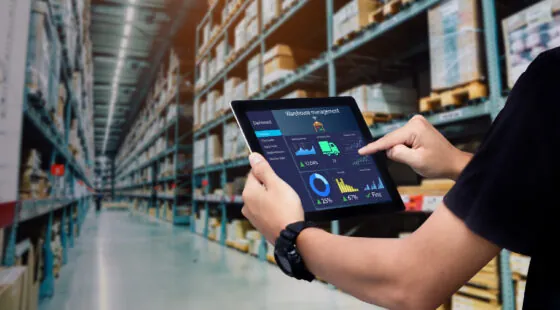Supply chain digitization, data management, and process standardization are among the top goals for the logistics sector. And the “means” most companies turn to for this is robotic process automation (RPA).
Robotic process automation (RPA) is a set of intelligent automation technologies for automating repetitive workflow steps and improving data flows between logistics systems. The results? Greater process efficiency, lower execution costs, reduced errors, faster processing times, and, ultimately, greater profitability – everything logistics businesses need in the current environment of economic volatility, geopolitical shifts, and labor shortages.
Discover how advanced logistics automation enables top companies to operate at warp speed and with unmatched productivity.
Key Use Cases of RPA in the Logistics Industry
A quarter of logistics businesses polled by APQC in 2024 have implemented RPA in logistics, ahead of other supply chain areas. Another two-thirds plan to implement an RPA tool for one of the next seven logistics use cases.
Order Management
The logistics business hinges on effective order processing and fast routing. Yet, the business processes for these are anything, but simple. Orders come from various sources, customs regulations change often, and reverse logistics adds another layer of complexity.
Further down in the supply chain, transportation managers are most concerned about last-mile misloads (24%), label inaccuracies (22%) and point-of-packaging mistakes (18%), according to the 2025 Supply Chain Integrity Outlook report.
In many cases, lack of operational efficiency and high error rates result from technology fragmentation. Data is siloed in different systems, leading to manual entries and errors. On average, mis-picks cost a warehouse $389,000 per year.
Logistics RPA solutions can create end-to-end, streamlined processes across multiple businesses – warehouse management systems (WMS), enterprise resource planning (ERP) tools, and transportation management systems (TMS) – reducing process execution speed and cost.
Pan-European logistics giant, Raben Group, first deployed an RPA proof-of-concept to automate spot offer generation. The manual process used to take 15 minutes. Its automated counterpart – 21 seconds- leads to faster sales team responses and higher customer satisfaction.
Following the successful validation, Raben Group built an internal RPA platform, that now hosts over 200 different automations, which do the equivalent work of 302 full-time employees a month, saving the business over €6 million annually.
Loadsmart, in turn, implemented an RPA solution to streamline pre-pickup communication with carriers. An intelligent procurement robotics process automation tool automatically confirms availability with each partner, reducing their average margin decay per load by almost 30% or $648,000 annually.
Warehouse Operations
A new order in the system triggers a flurry of action at the warehouses. The staff has to confirm inventory location and availability, cross-check order details against stock levels, and coordinate with shipping teams to ensure timely dispatch.
Ongoing shortages of warehouse workers (with 1.7 million vacant jobs in 2024) reduce the speed of task execution. Trade tensions and supply chain fragmentation, in turn, cause fluctuations in demand, requiring flexible operations to maintain service levels without incurring excessive costs.
Legacy WMS solutions often lack the customization and analytics the current pace of business requires. RPA solutions can compensate for these deficiencies and eliminate a great deal of repetitive work – courier data entry, inventory reconciliation, order validation, shipment scheduling, and exception handling. Software bots can automatically pull order details from emails or portals, cross-check stock levels in real time, and trigger fulfillment workflows without the ‘human touch’. They also ensure that tracking notifications are sent instantly to customers and stakeholders, reducing delays and improving overall supply chain visibility.
DB Schenker (DBS), one of the world's largest logistics providers, operating in 130 countries, considered RPA essential to its operation. The tool allows staff to track information from the carriers’ sides 50X faster, reducing update lead time by 80%.
The company also benefits from multiple logistics automation scenarios, supported by its flexible cloud platform with features like predictive forecasting, material requirements planning (MRP), purchase management, inventory management, and production-assembly management. Warehouse staff and the company’s customers also benefit from predictive shipment ETAs by tracking the good's progress from the point of the original purchase until the final arrival.
Shipment Scheduling and Tracking
Delivery speed is one of the key competitiveness factors for logistics players, and a lot of work goes into ensuring blazing-fast transportation. Most companies have a large task force allocated to coordinating delivery routes, optimizing vehicle capacities, and planning driver schedules.
However, (un)foreseen disruptions often cause havoc to the carefully laid out plans. Lack of real-time visibility and data fragmentation frequently result in overbooking or capacity constraints (e.g., insufficient dock space or personnel on-site). Naturally, this creates operational disruptions and affects customer satisfaction.
RPA logistics systems, integrated with the transportation management systems and warehouse management systems can help reduce scheduling conflicts by providing data on real-time demand and capacity. Such systems can reconcile tracking data from different carriers, providing accurate updates to customers and logistics managers.
Thanks to advances in AI, you can also configure ‘self-healing’ workflows, which would trigger a mitigation sequence in response to delays, rerouted shipments, or other disruptions, while also keeping the customers looped-in on their shipment statuses.
DHL Global Forwarding (DGFF) deployed an RPA bot to optimize airfreight. Using multiple sources of flight data, the bot automatically tracks the shipment status and generates a report that identifies potential problems. Consequently, the operations team could focus their attention on more important things, driving a 50% increase in efficiency. To date, DGFF has deployed over 160 different bots, shouldering the workload of an equivalent of 500 FTEs.
Invoicing and Payment Processing
Healthy cash flow is critical for every business. Yet, some logistics companies find themselves in ‘the red’ due to outdated invoicing systems, poor receivables tracking, and fragmented financial visibility. The ongoing escalation in the cost of transporting goods makes effective cash flow even more critical for protecting profit margins.
For an average logistics company, freight audit and payment automation can reduce freight settlement times by at least 6%, according to KPMG. In addition, automation improves payment accuracy and compliance.
RPA adopters concur. Fleet Innovation, a Finnish corporate car leasing company, has successfully automated almost half of its purchase invoice generation efforts, leading to better efficiencies and healthier financial standing. Schnellecke Logistics, in turn, automated over 80 processes, in particular financial ones in its SAP ERP, saving over 32,000 manual work hours for its people.
Documentation Management
Apart from finances, workers in the logistics sector spend about 50% of their work hours on other manual document management tasks, ranging from label creation to customs document generation – time that could otherwise be better spent.
Modern logistics RPA solutions include intelligent document processing (IDP) capabilities:
- Optical character recognition (OCR) for capturing and editing data from scanned paper documents, PDFs, or images
- Natural language processing (NLP) for better document data extraction, search, translation, and summarization
- Machine learning algorithms for faster, more accurate document data extraction and streamlined task execution
Thanks to these capabilities, logistics companies can automate the endless ‘firehose’ of incoming documents, siphoning away people’s time.
By using AI-enabled Nividous Smart Bots, a logistics company saved over 890 hours per month on processing letters of credit and shipping documents, while also improving process efficiency by 60%.
Brazilian shipper Inter Aduaneira achieved even more impressive results with its comprehensive RPA platform. Running 24/7, the tool collects information from import and export declaration records, import licenses, bills of lading, and official cargo tracking systems. Afterwards, it logs to government systems for customs declaration, saving each company analyst about 800 hours annually.
The company automated:
- 6,500 issued invoices
- 7,300 tax payment forms
- 5,550 air cargo system access
- 4,300 exportation processes
- 1,400 international trade process instructions
As a result, the response times improved by 80% in some processes, leading to better compliance and stronger customer relationships.
Regulatory Compliance
Global logistics businesses have to grapple with diverse (and sometimes conflicting) compliance requirements. New tariff threats, emerging sustainability requirements, data, and privacy regulations increase the cost of regulatory burden.
Only 9% of businesses say their supply chains comply with the EU’s Corporate Sustainability Due Diligence Directive, issued in July 2024. Another 30% admit they’re behind in their compliance efforts. In other words, compliance management can put a big dent in your budget and strain resources. And that’s exactly what makes it another great use case for RPA deployment.
Take it from adopters. With the integration of over 22,000 shipment documents per month and the automatic collation, consolidation, and distribution of the necessary documents, a logistics company saves over 2,200 hours on admin and compliance tasks monthly.
Expo Group, in turn, automated its freight forwarding process, including compliance checks for booking confirmations, cargo receipts, and shipment documentation, saving 87% of working hours.
Fleet Management
With ongoing fuel cost volatility, logistics companies are pressed to optimize consumption. Rising maintenance expenses, inefficient route planning, and vehicle downtime further add to the challenge.
Yet, many companies are held back by legacy fleet management systems (or even lack of their off). In the UK, 60% of SME fleet managers rely on multiple digital spreadsheets to track costs, manage dispatches, or calculate millage. Naturally, this leads to slow decision-making and mistakes. Errors in fuel card reconciliation, mileage tracking, and vehicle utilization inflate operating costs.
RPA solutions can streamline a range of fleet management tasks such as:
- Fuel usage monitoring
- Mileage tracking and reporting
- Route planning
- Dispatch management
- Maintenance scheduling
- Driver log automation
- Vehicle inspection scheduling
- Toll and fuel card reconciliation
Automated workflows help dispatchers assign vehicles based on availability and optimal routes, cutting down on idle time and fuel waste. To identify improvement opportunities, an UAE-based logistics company deployed an RPA algorithm to analyze historical routes, traffic patterns, and delivery times. Algorithmic suggestions brought in a 15% reduction in annual fuel costs and a 25% decrease in average delivery times, according to the case study.
By combining RPA with predictive analytics systems, logistics businesses can also gain foresight into fleet servicing needs, fuel consumption trends, and overall operating efficiencies. This, in turn, could help streamline processes like spare parts re-ordering, preventive maintenance scheduling, and vehicle replacement planning.
Main Challenges and Considerations When Implementing RPA
The brilliance of robotic process automation is that it’s a plug-and-play technology that works across any platform. Most tools act like "glue" connecting otherwise disparate software systems to deliver seamless data exchanges and end-to-end process execution.
Generally speaking, the implementation process is straightforward, especially if you work with a managed services provider (like Svitla Systems). That said, there are a few key factors to consider when adopting RPA in logistics.
Vendor Selection
RPA is a $2,8 billion market, with a host of domain-specific and global technology vendors. Big Tech companies like Microsoft, Oracle, and IBM offer customizable cloud RPA platforms.
Independent players like UiPath, Automation Anywhere, and Appian, in turn, are more platform-agnostic and have more cost-effective pricing.
To choose the right option, logistics leaders should consider factors like:
- Compatibility. Will the platform integrate with other software in your ecosystem?
- Scalability. Is it robust enough to support a larger user base and higher workloads?
- Customization. Can you adapt it for new use cases and complex business processes?
- Security. Will your sensitive shipment data and customer details be well-protected?
Beyond technical characteristics, consider value-added offerings like user training programs, ongoing maintenance, and proactive customer support. Lastly, pricing obviously matters. Prioritize vendors with transparent licensing structures and transparency in extra charges to avoid an inflated TCO.
Integration with Legacy Systems
Two-thirds of shipping and logistics firms have digital transformation initiatives underway, but moving complex systems like on-premises databases, ERPs or TMS is a long process. RPA solutions can help deliver some ‘quick wins’, providing newer cloud software with access to data in legacy systems.
But there are also technical constraints to account for. For example: legacy data formats that cannot be effectively processed with RPA tools or limited workload concurrency. Doing a technical audit of your legacy software and documenting all the constraints is an essential first step in RPA adoption. Validate that the selected RPA tool will be able to pull, update, and reconcile information across disparate systems without errors or costly reworks.
Additionally, consider vendors that provide pre-built automation templates or connectors for common logistics software, reducing the need for extensive custom development.
Data Security
RPA logistics tools create new data flows, improving knowledge flow and process execution. But the flip side of greater connectivity are higher cybersecurity risks. Every shipment, invoice and customer detail, processed by an RPA tool, is a potential target for cyber criminals.
Consider RPA vendors with embedded safeguards such as encryption for data at rest and in transit, role-based access controls, and MFA. GDPR, SOC 2, and ISO 27001 compliance are also good indicators of strong data privacy and security.
Assign deployed bots with the ‘least-privilege’ access to prevent accidental data leaks. Schedule regular audits and activity logs to monitor RPA deployment in production and detect any performance anomalies early on.
Workforce Training
To unlock the full value of RPA, you’ll need to get your workforce onboard. Without proper training, your people may struggle to maximize automation’s benefits or resist adoption altogether.
Engage your staff early in the adoption process. Ask them to describe their top challenges in their work, and comment on gaps in existing workflows or current technologies. Then use the feedback to formalize your business case, prioritize RPA use cases, and later on, present how the new RPA solution addresses the expressed concerns. Hands-on workshops and access to on-demand learning resources can further help employees get accustomed to new RPA tools.
Creating an environment where employees feel comfortable using RPA can boost adoption rates, improve operational efficiencies, and create a more productive and empowered logistics workforce.
Conclusion
Logistics automation solutions can ‘plug’ the manual gaps in a roster of business processing, helping businesses recoup costs and improve resource allocation. Order management, payment processing, shipment tracking, and regulatory compliance workflows can become up to 10X more effective with the right logistics RPA solution.
Learn how to determine if your business needs to invest in RPA from our previous blog post. Or get in touch with one of our RPA experts to get a more personalized take on the best use cases and RPA adoption scenarios for your business.

![[SM cover] How RPA Is Revolutionizing the Logistics Industry](https://svitla.com/wp-content/uploads/2025/03/SM-cover-How-RPA-Is-Revolutionizing-the-Logistics-Industry-936x527.jpg)
![[SM cover] How RPA Is Revolutionizing the Logistics Industry](https://svitla.com/wp-content/uploads/2024/03/Nataliia-Romanenko-236x236.jpg)


